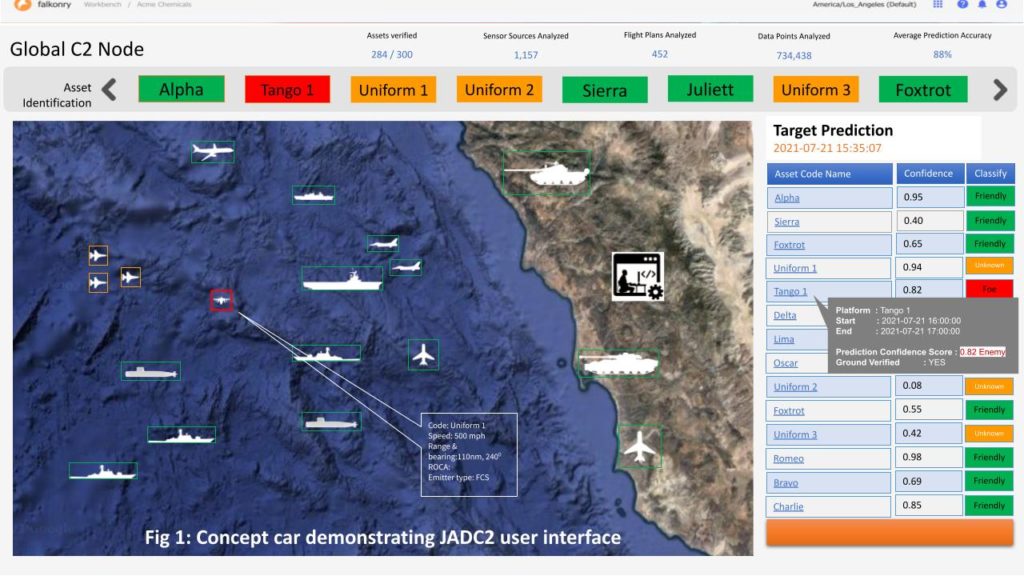A day in the life of a defense analyst utilizing time series AI
Key takeaways:
- Falkonry's time series AI is able to ingest data from heterogeneous sources in scenarios such as Joint All Domain Operations and can classify ‘normal’ and ‘non-normal’ behavior of assets.
- Analysts benefit greatly from Falkonry’s pattern recognition and classification technology on sensor and other machine-generated data to understand behavioral states of any asset, no matter how complex.
- Falkonry drives AI-enabled rapid, effective decision making in complex operational pattern-of-life analysis.
In recent years, Artificial intelligence (AI) has gained greater acceptance in the military domain. Top military organizations around the world are moving from research and development in AI to adopting AI for delivering real-time performance improvements in the field. Falkonry is an innovation leader in delivering AI/ML-driven intelligence to bring improvements in operational readiness as well as situational awareness in defense operations. Here is an example of what a day in the life of a defense analyst looks like when time series AI is at hand to aid decision-making.
Scenario in joint operations
One of the most important aspects of any tactical operation is target identification. In air operations, the problem is complicated by long ranges and by similar-looking aircraft. Unless a threat is ascertained, counteroffensive action cannot be initiated. In the following sections we explore how target identification using temporal pattern discovery and classification techniques can help an analyst make the right decisions.
Take as an example a simulated war exercise involving Red and Blue forces in which there is bi-directional real-time data sharing between airborne platforms, naval platforms, and army units. Operational data such as target tracking and cockpit sensor data is exchanged by air platforms to the operational ground system via the Navy’s data link and subsequently to Battle Command Systems to conduct a simulated fire exercise.
At a joint command center, an analyst is going about her (or his) duties when she receives notification via her workstation that there has been an anomalous pattern of behavior detected in a geographical area that the analyst is responsible for monitoring. The pattern corresponds to multiple ‘Red Force’, ‘Blue Force’ temporal signals ingested by Falkonry’s time series AI from diverse sensors in the simulated exercise. She uses the notification to go to the event in the Falkonry Web UI. She confirms the timing and duration of the anomalous pattern by reviewing the visual display of pattern and signal data. Then she checks the explanation information to understand the most important contributors to flagging the pattern as something new. Falkonry returns a list of sensor data such as ISR/EW data, tracks, flight path, speed, direction and target signature, as the most important factors. Using this list, the analyst concludes that the target is identified appropriately and marked for future use. This disposition is then fed back into Falkonry, providing an example of target identification, which can be recognized directly should it be seen again.
While this analysis was happening, another alert was sent to the analyst’s workstation. In this case, the alert is for a previously identified target. Because this had been seen and dispositioned before, the classification was provided automatically for the analyst to review and confirm. This can be automated with a decision workflow that enables selection of a weapon or a counter-offensive launch confirmation.

As the result of a separate meeting, the analyst decides it would be interesting to see if she could detect a particular behavior of a specific type of target by a competitive power. There are a few known examples of this behavior. The analyst labels these behaviors in the Falkonry Web UI as well as a few periods of time where nothing unusual is happening as reference. She quickly builds and then iterates on a model which detects patterns of behavior that are similar to the behavior of interest. As a result, the analyst identifies 10 events of interest that were previously unknown. She uses this information to compile a report and advance discussions about what these behaviors mean in the broader mission context. Based on the subject matter expertise and discussions with the Joint Force Commander, the command center is able to decide to build an automatic workflow to choose the best counter behavior or selection of weapons for combat readiness.
In this case, instead of relying on traditional NCTR technology that uses a huge library of existing reference target signatures, Falkonry’s time series AI exploited patterns across a diverse set of signals to augment object identification in an ambiguous scenario. Additionally, the digital fingerprint of the target behavior is continuously updated based on the detected pattern of signals for real-time use in future scenarios. This can also be immensely useful in pilot training analysis and de-briefings to identify skill gaps or repetitive errors that might otherwise be too subtle for a human to detect unaided.
Note: All the scenarios mentioned above are fictitious and for complex data analysis capability demonstration purposes only.





